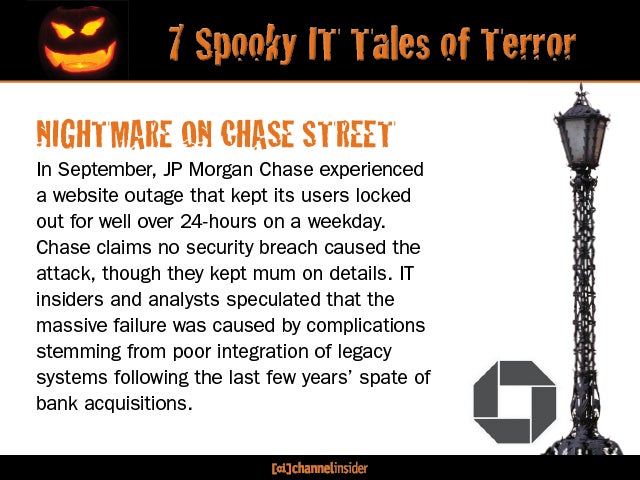 Nightmare on Chase Street
Nightmare on Chase Street
In September, JP Morgan Chase experienced a website outage that kept its users locked out for well over 24-hours on a weekday. Chase claims no security breach caused the attack, though they kept mum on details. IT insiders and analysts speculated that the massive failure was caused by complications stemming from poor integration of legacy systems following the last few years’ spate of bank acquisitions.
 Ghost in the Smartphone
Ghost in the Smartphone
This fall Verizon was slammed by the FCC over complaints that it was overcharging customers for years for data services that these users didn’t initiate. This month, Verizon announced that it would pay out $50 million to 15 million users to make good on the mistake, which Verizon said was caused by a software glitch.
 Sometimes They Come Back…for a Refund
Sometimes They Come Back…for a Refund
In June, systems integrator EDS was stung with a $460.3 million settlement for a contract that it was unable to fulfill for BritishSkyBroadcasting. BSkyB claimed that when it agreed to pay $75.7 million for EDS to build it a new CRM solution, the decision was made based on capability claims that EDS made that a BSkyB lawsuit eventually claimed were false and deceitful.
 It Came from Outer Clouds
It Came from Outer Clouds
Approximately 50,000 Australian travelers were left grounded in September by airline Virgin Blue when an infrastructure failure at its cloud host, Navitaire, a business process outsourcing (BPO) unit of Accenture, interrupted customer-facing system functionality. The disruption was caused by a solid-state-disk failure and some bungling of disaster recovery procedures, mistakes that cost the airline as much as $20 million.
 Fail Safe Failure
Fail Safe Failure
Just this week a computer failure at F.E. Warren Air Force Base in Wyoming caused the type of system malfunction that would make any death-fearing citizen soil their pants: a nuclear one. The launch computers at the base went down, causing a whole squadron of Minutemen III intercontinental ballistic missiles to lose communication with ground-based launch control and to disrupt security controls that keep bombs from being deployed accidentally.
 Dr. Jeckyll and Mr. Hype
Dr. Jeckyll and Mr. Hype
Antenna Gate proved that Apple PR is capable of slinging PR BS with the best of them. Apple’s backpedaling and bizarre workarounds had its fan boys wondering how the company could have such a split personality.
 Dawn of the Dead Dells
Dawn of the Dead Dells
Did you or your customers experience a lot of problems from unstable Dells from 2003 and 2005? Chances are you weren’t alone. A lawsuit unsealed earlier this year and broken by the New York Times claims the computer maker shipped around 12 million units with faulty capacitors and then tried to cover up the mistakes with lies. It’s a frightening cautionary tale on the importance of vetting vendors and holding them accountable.

